






|

By Prof. George Dissanaike

The colourful spectacle of the setting Sun and
the evening sky is an inspiring sight and a joy to behold.
Yet few realise that a sunset can reveal the presence of pollution in
the atmosphere. The colour of the Sun's disc, for example, is quite different
in a polluted atmosphere as in a clear and unpolluted one. In an exceptionally
clear and unpolluted sky, the sunlight is scattered primarily by air molecules.
In accordance with theory, it is the shorter wavelengths (in the blue region)
that are strongly scattered out, so that the sky away from the sun seen
by scattered light has the characteristic 'sky blue' colour. The sun disc
itself is an intense yellowish-orange (white minus blue). In a polluted
sky however, the presence of pollutant particles changes the picture completely.
It is the pollutant particles of larger sizes that dominate the scattering
and determine the colours seen.
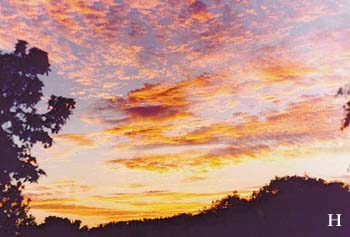
 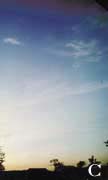 As
an example of sunsets in a clear and unpolluted atmosphere, some photographs
of a sunset, taken from the hill overlooking the campus of the University
of Peradeniya, are shown in Fig. A-C. In Fig. A, the sun's disc itself,
seen by transmitted light, is an intense orange -yellow, while the adjacent
sky shows shades of orange and yellow. Far across the sky, shades of blue
are seen. As the sun sets below the horizon, Fig. B, the colours in the
western sky gradually change from orange red to blue. Low lying clouds
reflect the sunlight (from the sun already set) showing a reddish hue.
Thin clouds higher up show a tint of mauve, reflecting the blue of the
sky mingled with the reddish hue of the sun's rays. Finally, in C, the
sky shows beautiful shades of blue, before the curtain of darkness falls. As
an example of sunsets in a clear and unpolluted atmosphere, some photographs
of a sunset, taken from the hill overlooking the campus of the University
of Peradeniya, are shown in Fig. A-C. In Fig. A, the sun's disc itself,
seen by transmitted light, is an intense orange -yellow, while the adjacent
sky shows shades of orange and yellow. Far across the sky, shades of blue
are seen. As the sun sets below the horizon, Fig. B, the colours in the
western sky gradually change from orange red to blue. Low lying clouds
reflect the sunlight (from the sun already set) showing a reddish hue.
Thin clouds higher up show a tint of mauve, reflecting the blue of the
sky mingled with the reddish hue of the sun's rays. Finally, in C, the
sky shows beautiful shades of blue, before the curtain of darkness falls.
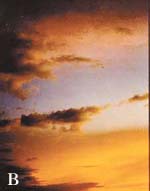 In
a highly industrialised region of the world, where pollutant aerosols cloud
the atmosphere, the colours in the sky at sunset are quite different. In
a highly industrialised region of the world, where pollutant aerosols cloud
the atmosphere, the colours in the sky at sunset are quite different.
For example, picture D, portrays such a sunset (in Boston, Massachusetts
in 1970). The sun's disc appears a bright orange red, the sky around a
duller red, with different shades seemingly indicating layers of pollution.
On certain days when the pollution is particularly heavy, the sun appears
as a dull red disc, as in E that may sometimes fade away before it even
reaches the horizon.
Photographs of sunrise have also been taken from an aeroplane. At such
high altitudes, the observer has quite different views of a sunrise.
Picture F portrays a sunrise in an exceptionally clear atmosphere, taken
from a plane at 10 km altitude over the Indian ocean, about 1000 km from
Sri Lanka. The sunlight is scattered mainly from the upper region of the
atmosphere closer to the eastern sky. Before sunrise, exceptionally vivid
colours, of orange yellow, pink, mauve and deep blue are seen in the eastern
sky.
Generally the Earth's surface is clearly visible, painted near the horizon
in a splash of red once the sun appears over the horizon. In sunrise observed
at 9 km altitude from a plane, flying over the Middle East and approaching
Oman, several months after the Kuwait oil fires in mid 1991, we see a different
scene.
Before sunrise, a thick blanket of pollution was observed, well below
the height of the plane, covering the entire region. When the Sun appeared,
it did so as it were through the blanket of pollution. The sky above was
dull, compared to the gorgeous sky observed over the Indian Ocean, as described
earlier.
 In
1908, Gustav Mie put forward a general theory of scattering of light that
covers a wide range of particle sizes. The theory can be used to explain
the effects observed in polluted skies, where there are particles (pollutant
aerosols) much larger than the air molecules clouding the atmosphere. In
1908, Gustav Mie put forward a general theory of scattering of light that
covers a wide range of particle sizes. The theory can be used to explain
the effects observed in polluted skies, where there are particles (pollutant
aerosols) much larger than the air molecules clouding the atmosphere.
Scientific theories predict that the intensity of the scattered light
increases as the sixth power of the particle size, so that the larger particles
completely dominate the scattering.
As the particle size increases, more and more of the yellow, green,
as well as the blue are scattered out, so the transmitted light is much
less intense and gradually assumes a reddish hue.
The colours of the Sun as it sets, shown in A (in an unpolluted sky),
and in D and E (for a polluted sky) illustrate this clearly. When the particle
size increases further, the reddish hue fades away. Mie's theory specifically
predicts that when the Sun is covered with a cloud of single-sized particles
of 0.85 mu the extinction of the transmitted light is a minimum in the
blue region, giving rise to a blue Sun, and when the particle size is 1.1
mu ( i.e. nearly twice the wavelength of light), the minimum is in the
green region of the spectrum, giving a green Sun.
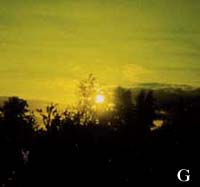 Photograph
G, of a rare sunset taken in Edinburgh in July 1991 show clearly green
and yellow hues in the sky around the Sun, in the late afternoon and at
sunset. The Sun at that time was covered with a fine haze. Photograph
G, of a rare sunset taken in Edinburgh in July 1991 show clearly green
and yellow hues in the sky around the Sun, in the late afternoon and at
sunset. The Sun at that time was covered with a fine haze.
It is the size of the particles scattering the sunlight that determines
the intensity and the colours of the Sun's disc and of the surrounding
sky. In a clear unpolluted atmosphere, it is the air molecules that would
scatter the light, giving rise to the colourful sunsets observed, and in
a polluted atmosphere, it is the presence of pollutant particles, very
much larger than the air molecules, that would dominate the scattering,
giving rise to dull skies and sunsets (or sunrise), as depicted in pictures
D, E or G.
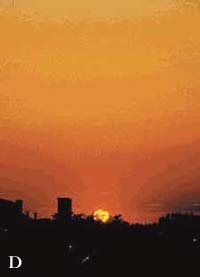 A
month ago, a spectacular sight was observed in Kandy just before sunrise,
with a myriad of cloudlets reflecting exceptionally vivid colours in the
eastern sky, to herald the dawn of a new day, on this the 50th year of
Independence as in the big picture above. A
month ago, a spectacular sight was observed in Kandy just before sunrise,
with a myriad of cloudlets reflecting exceptionally vivid colours in the
eastern sky, to herald the dawn of a new day, on this the 50th year of
Independence as in the big picture above.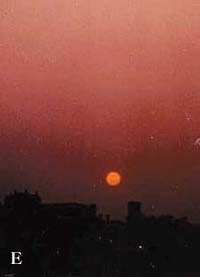
An important question arises. Fifty years from now, as our nation celebrates
the centenary of Independence, would the skies be clean and clear to portray
such a colourful sight early morning ?
Alternatively, would our skies be much like those in the heavily polluted
regions of the world, presenting each morning a dull sight. The choice
is ours, the responsibility is ours today.
The writer is attached to the Department of Physics, University of Peradeniya.
|







